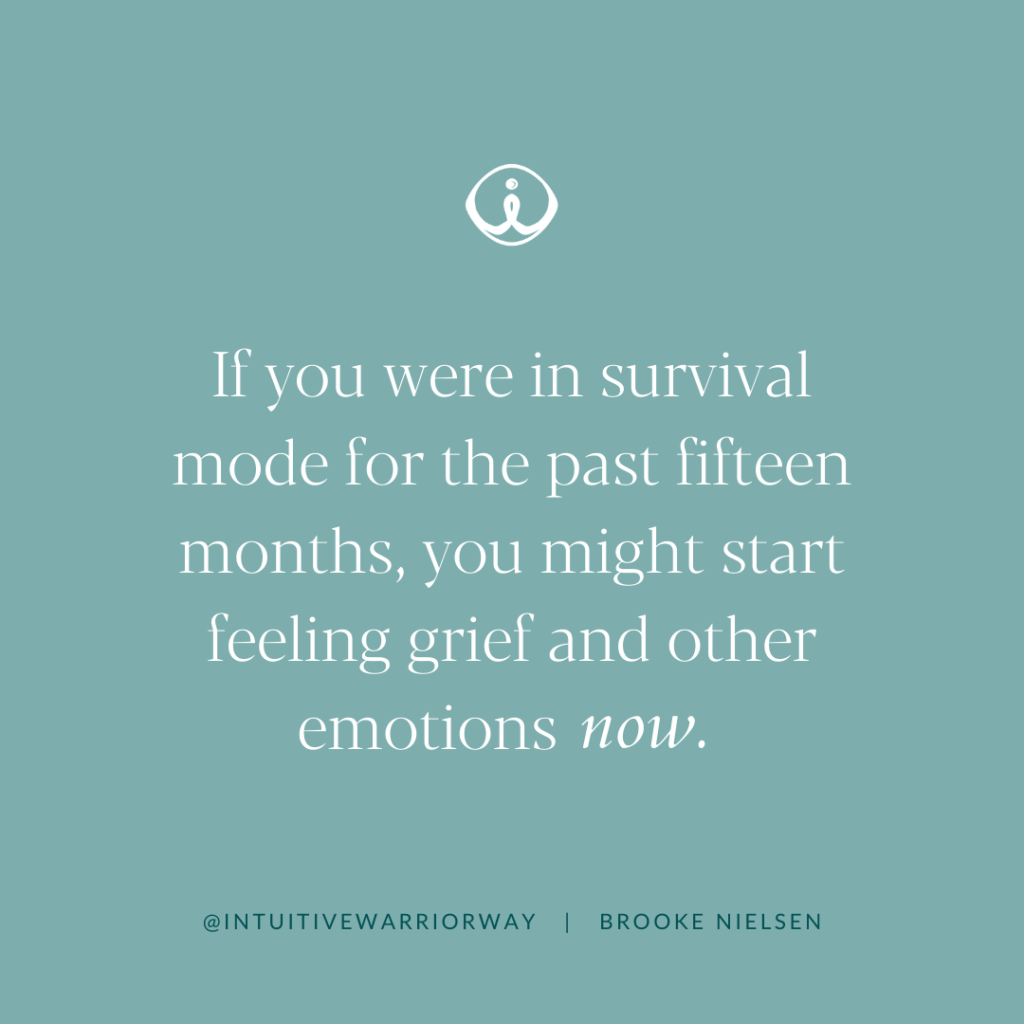Last week on Instagram, one of our posts got more comments and likes than we’ve ever gotten.
It struck me how much it resonated with so many people in our community, so I want to continue to bring attention to something that so many are clearly experiencing right now (and not talking about).
Here’s what the post said: If you were in survival mode for the last 15 months, you might be feeling grief and other emotions now.

Humans are amazingly resilient beings. One of the ways that we’re resilient is that we have the capacity to go into survival mode (fight/flight/freeze/faint/fawn) when needed in order to get through hard things.
Survival states often cause us to compartmentalize emotions that we’d otherwise be having because there’s just not room for them.
As an example, imagine that you broke your leg. In that moment, your shock, anger, sadness about the situation aren’t as relevant as is getting to a hospital. Some or all of those feelings would wait patiently until they could safely be felt.
Similarly, some of the grief, shock, despair, anger, loneliness, and trauma (to name a few) that you experienced the past year may have needed to wait while you dealt with immediate needs and the task of staying safe, caring for loved ones, and just getting by.
As the immediate danger has diminished for many of us, don’t be surprised if some of those compartmentalized feelings seem to bubble up “out of nowhere”.
Our Emotions Catch Up With Us
As a sensitive person, the emotions that arise can be intense and catch us completely off guard (I know I’ve had a few days lately where the intensity of my feelings has taken my breath away).
To support yourself through this understandable, natural process, here are here are 5 things to try:
1. Make room for the feelings
Many of us learned to stuff, stuff, stuff our feelings – meaning we push them down and don’t allow them to move through us or be expressed – in order function, avoid criticism, and feel acceptance from those around us.
But that repression comes back to bite us in the end. Feelings need to be felt and they need to be allowed. Only then will they resolve and be on their way.
So if you’ve been compartmentalizing over the past year, it’s now time to start making room for those feelings. Can you take out your journal and free-write for 5 minutes a day? Can you go on a walk and start to acknowledge what you’ve been holding in? What about doing some gentle yoga or simply finding a quiet space and letting yourself cry?
2. Name your feelings
Dr. Daniel Siegel coined the term “Name it to Tame it”. Research shows that when we name our emotions, they feel less intense (the part of your brain that recognizes danger becomes less activated, and the part of your brain responsible for problem solving and big-picture thinking becomes more activated).
So as you let yourself feel or acknowledge your emotions, try putting a name to them, such as “I feel sad”, or “I feel angry”. It’s as simple as that.
3. Create some structure so you’re not overwhelmed
Part of being highly sensitive is having intense emotions, but if our feelings are too intense, we can get overwhelmed.
If you’re feeling overloaded, try creating some simple structure to center yourself. One way to feel immediately more grounded is to use the 5-4-3-2-1 tool (name 5 things your see, 4 things you hear, 3 things you feel [touch], 2 things you smell, and 1 thing you taste).
I also love using the acronym G.R.A.P.E.S. to add some structure and balance to my day.
G = gentle self talk (“I will get through this”, “I allow all my feelings”, etc)
R = relaxation (soak up 10 minutes of sun, do a 5 minute meditation, take a bath)
A = achievement (cross one thing off your to-do list. keep it small)
P = pleasure (read a book, get a massage, anything that creates a good feeling)
E = exercise (any bit of movement that feels good to you will do)
S = social (send one text and let someone know you’re thinking of them)
4. Move your body
Even though I mentioned this above, it’s worth restating. When we’re feeling a lot, it can be easy to get too busy or get too still. Finding the right type of movement for where you’re at can help your energy and emotions to move productively.
If you’re anxious and jittery, this is probably not the time for a run (which can make your stressed body think you’re needing to flee). Consider something more grounding like walking, swimming or gentle yoga.
If you’re feeling frozen or lifeless, bringing more energy to your body can be helpful. Try things like weight lifting, jumping on a trampoline or brisk walking.
The key here is listening to your body and what it needs.
5. Get support to walk through it with someone
We’re not meant to go through tough emotions alone. You might risk being vulnerable and reach out to the safe people in your life. Share about what you’ve had to compartmentalize or what’s coming up.
At Intuitive Warrior, supporting HSPs through times like this is what we love to do. Sometimes professional support from someone who can hold space for you and who gets Highly Sensitive People is exactly what’s needed. Find out more about our gentle, one-on-one HSP coaching here.
I hope those ideas were helpful, and more than anything, I hope this validated where you’re at right now.
Remember, let this process be messy. And please allow yourself to get support; you don’t have to do this alone.

Good post. I learn something new and challenging on blogs I stumbleupon everyday. Its always useful to read articles from other writers and use something from their web sites.
Excellent post. I certainly appreciate this website. Keep writing!